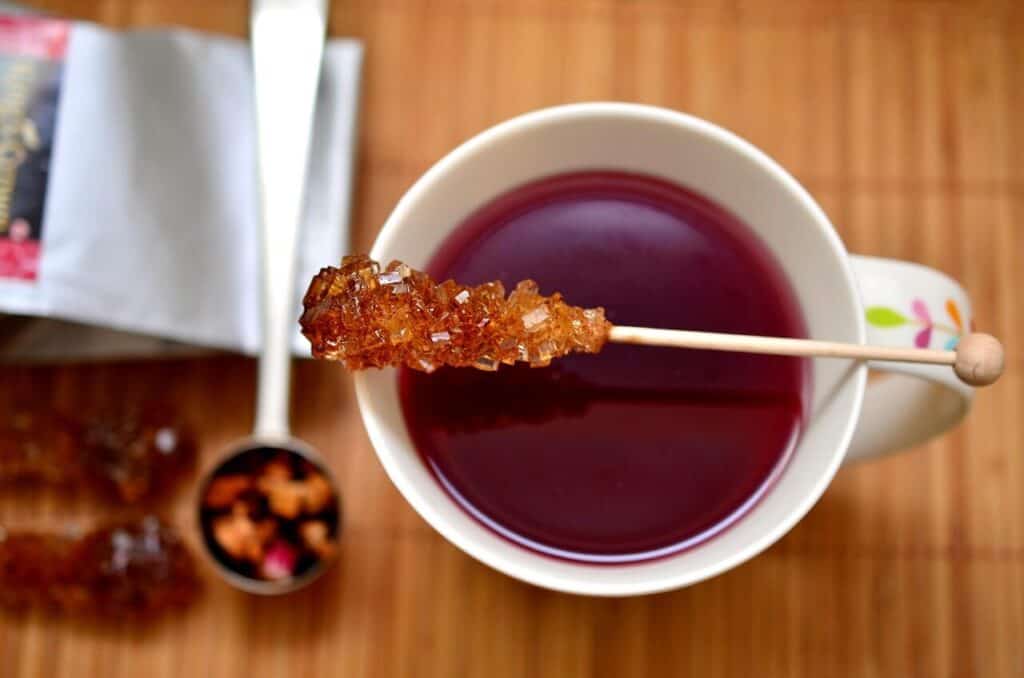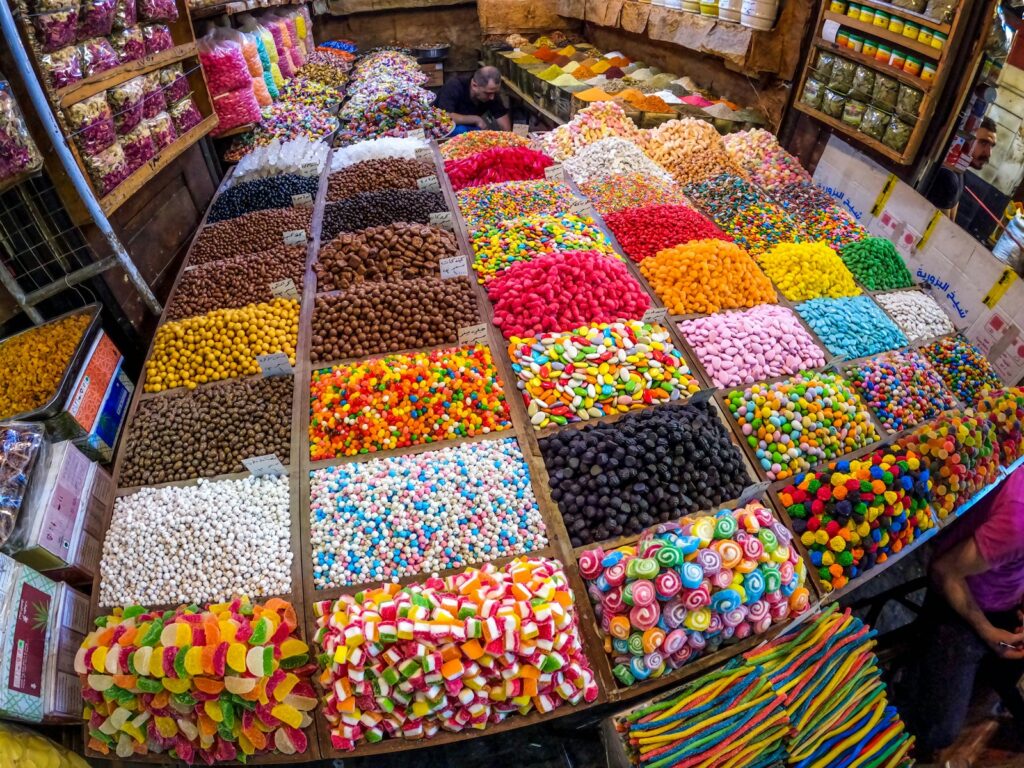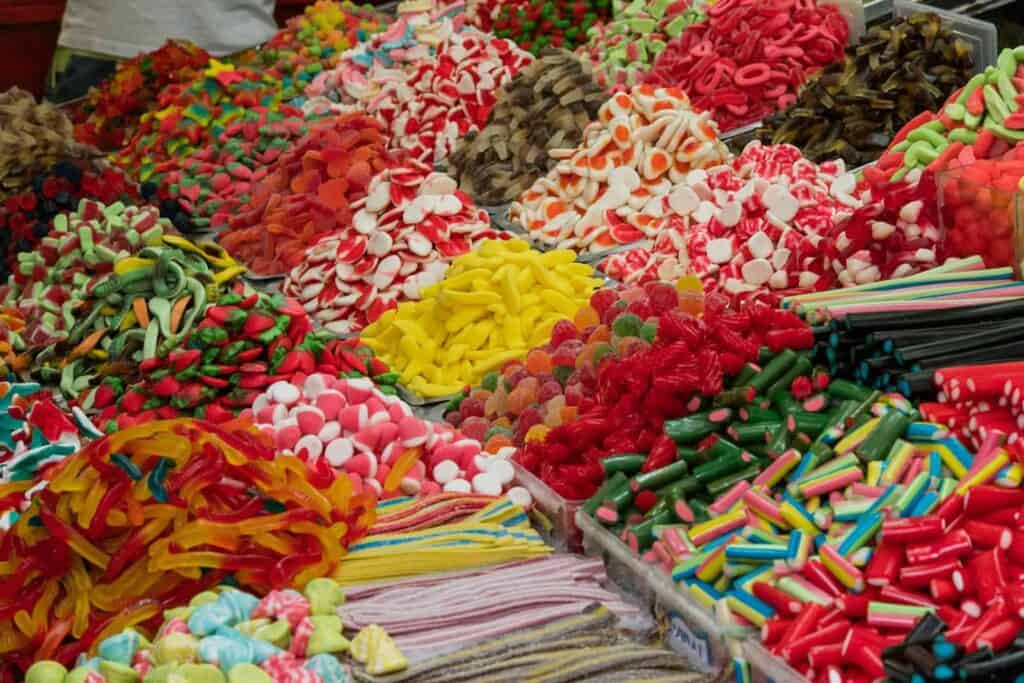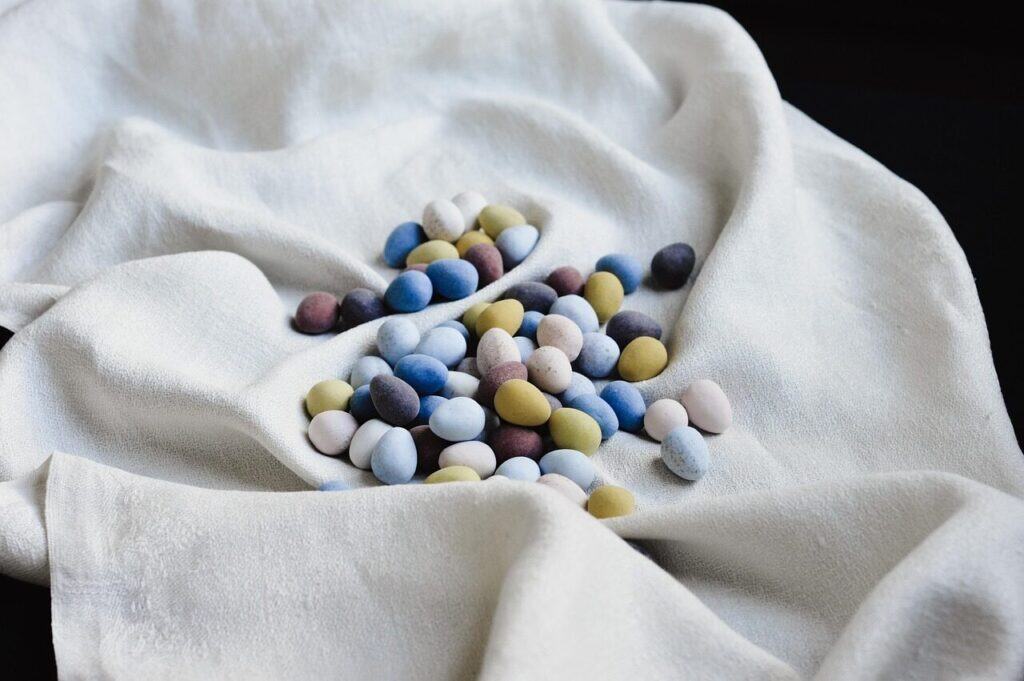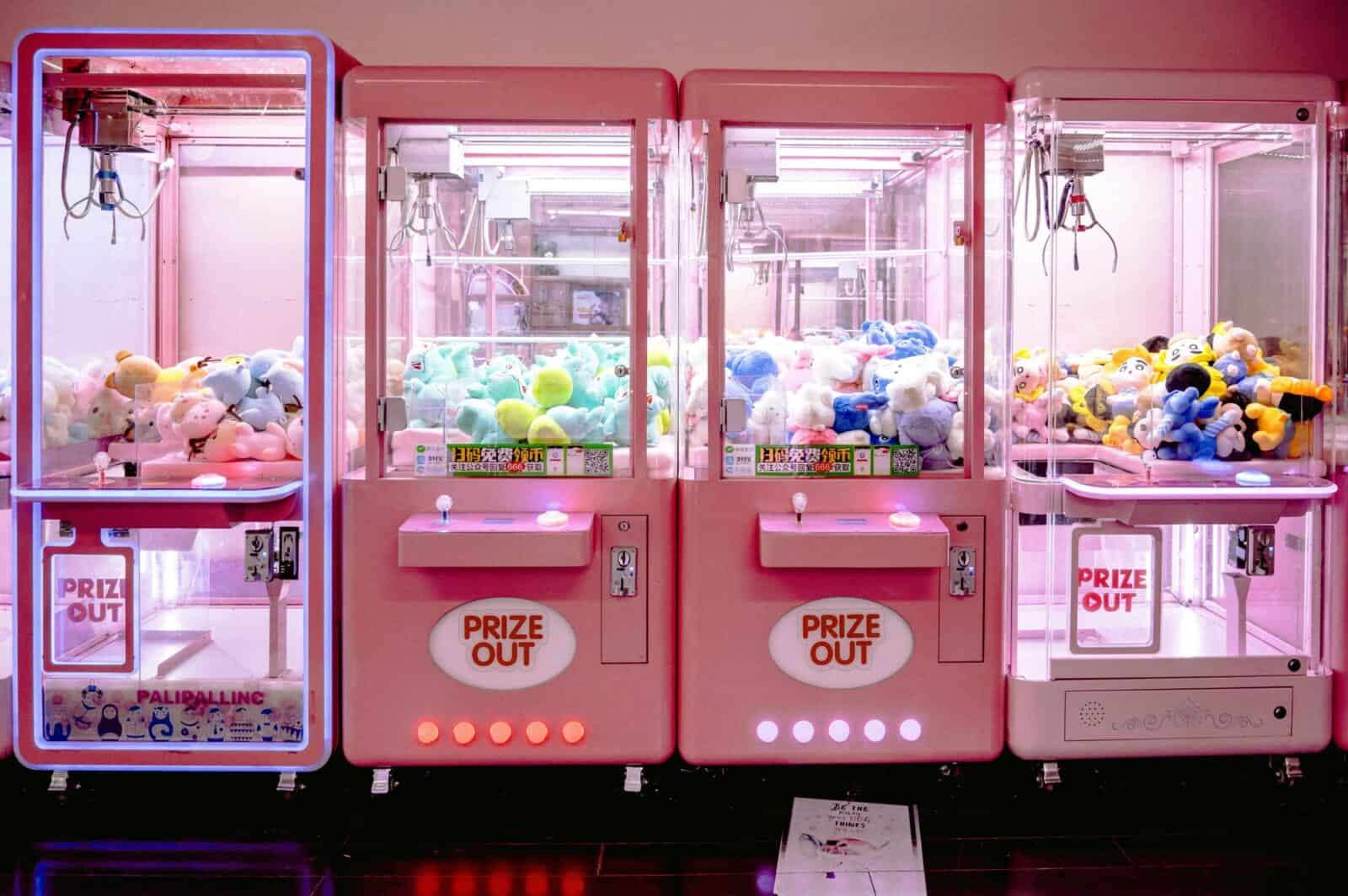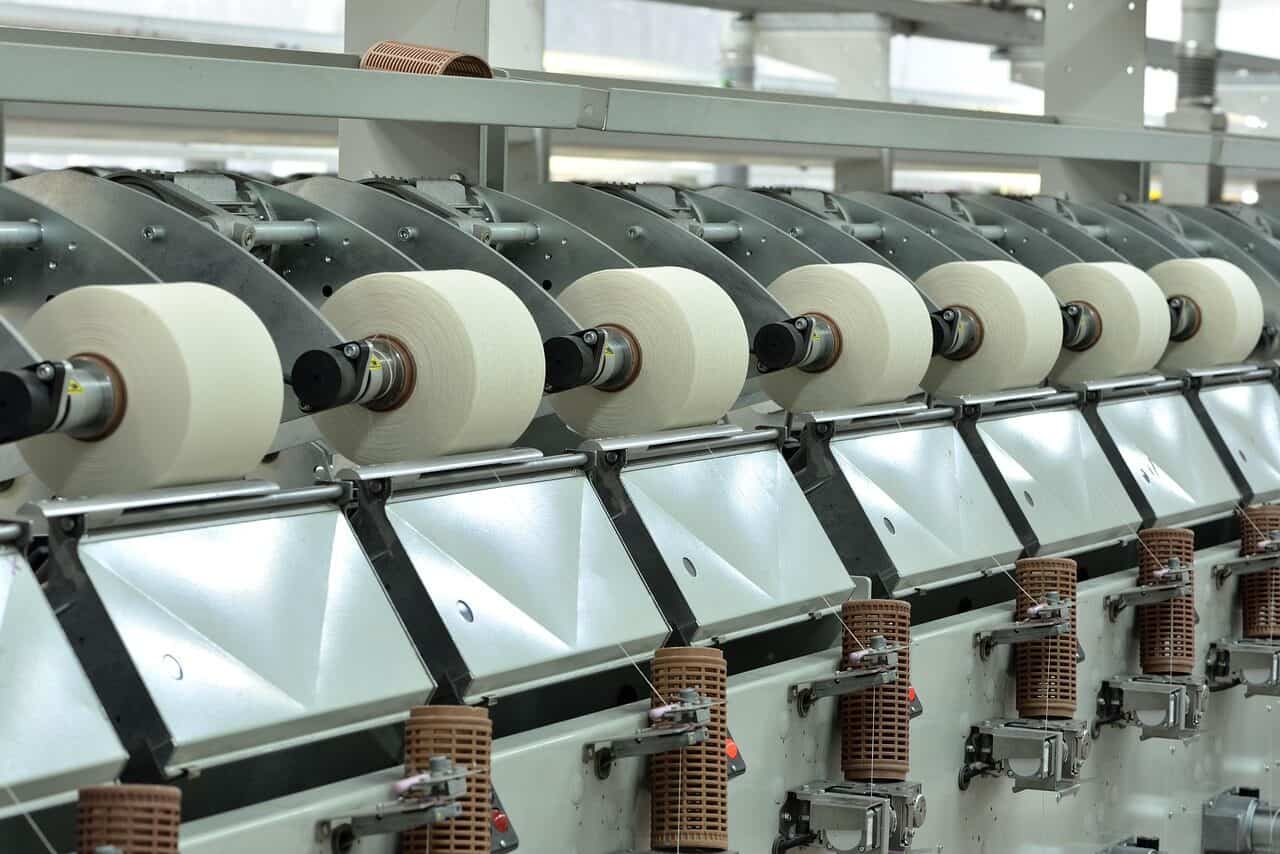A ciência do doce: A Technical Analysis of Modern Soft Candy Production (Uma Análise Técnica da Produção Moderna de Doces Macios)
O ursinho de goma parece simples. Mas, na verdade, é uma maravilha da ciência dos alimentos. Fazer um não é apenas seguir uma receita. É uma mistura precisa de química e física. A mastigabilidade, o sabor e a estabilidade do produto final resultam de interações cuidadosamente controladas em um sistema complexo.
Este artigo vai além das instruções básicas. Ele fornece uma análise técnica abrangente da produção moderna de balas macias. Detalharemos os princípios científicos subjacentes, desde a química do açúcar até o comportamento dos agentes gelificantes. Examinaremos os parâmetros críticos de controle de processo que garantem um produto consistente e de alta qualidade.
Nossa jornada abrange a base científica dos ingredientes, uma comparação de agentes gelificantes, uma análise passo a passo da fabricação e um guia para pontos críticos de controle e solução de problemas técnicos. Este é um mergulho profundo para profissionais que desejam dominar o ciência por trás do doce.
A Fundação Científica
Para realmente controlar os resultados da produção de balas macias, precisamos primeiro entender o papel de cada componente em nível molecular. O doce final é um sistema cuidadosamente equilibrado. Açúcares, hidrocolóides, ácidos e água existem em um estado específico e projetado. Esta seção detalha esses ingredientes principais para estabelecer os primeiros princípios de formulação.
A espinha dorsal do açúcar
A base de qualquer bala macia é a espinha dorsal do açúcar. Isso proporciona doçura, volume e, o mais importante, controla a textura por meio de seu estado físico.
A sacarose, ou açúcar de mesa comum, serve como adoçante principal e base estrutural. Entretanto, se usada sozinha, a sacarose cristaliza facilmente. Isso resulta em um produto granulado, doces duros em vez de maciosmastigável.
Para lidar com isso, introduzimos os "agentes medicinais". Esses são principalmente xaropes de glicose. Esses xaropes são misturas de vários açúcares e atuam como agentes interferentes. Eles impedem fisicamente que as moléculas de sacarose se alinhem em uma estrutura cristalina ordenada.
O objetivo é manter a solução de açúcar em um estado supersaturado, amorfo ou "vítreo". Essa estrutura não cristalina dá ao doce macio sua característica de clareza e mastigação. A proporção de sacarose para xarope de glicose é fundamental. Um ponto de partida típico é uma proporção de 60:40.
O tipo de xarope de glicose também é importante. Ele é definido por seu Equivalente de Dextrose (DE). Um xarope com DE mais baixo contém mais carboidratos de cadeia longa. Isso aumenta a viscosidade e proporciona mastigação. Um xarope de 63 DE mais alto é mais doce, menos viscoso e mais propenso a dourar durante o cozimento.
A matriz hidrocoloide
O elemento textual que define o doce macio vem de sua matriz hidrocolóide. Esses são polímeros de cadeia longa que criam uma rede para reter a água, formando um gel.
Os hidrocolóides, como a gelatina ou a pectina, são dispersos no xarope de açúcar quente. Durante o resfriamento, esses polímeros passam por uma transição de fase. Eles se unem para formar uma rede coesa e tridimensional. Esse processo é chamado de gelificação.
Imagine uma rede microscópica de cadeias de polímeros se formando à medida que o doce esfria. Essa rede prende o xarope de açúcar e as moléculas de água em sua estrutura. Ela impede que elas fluam livremente e cria a textura sólida, porém maleável, que reconhecemos como uma goma ou gelatina.
Nosso foco é controlar a atividade da água (a_w), não apenas o teor de umidade total. A atividade de água mede a quantidade de água "livre" ou "disponível" no sistema que os micróbios podem usar. Ao ligar a água dentro do gel hidrocoloide e por meio da alta concentração de açúcar, reduzimos o a_w. Isso garante que o produto seja estável na prateleira e seguro sem refrigeração.
Ácidos, tampões e aromas
Ácidos, tampões e sabores são adicionados para proporcionar as características sensoriais finais. Eles também controlam as principais reações químicas durante o processo.
Ácidos como o cítrico, o málico e o tartárico têm uma dupla finalidade. Eles proporcionam a acidez característica que equilibra a doçura intensa do doce. Eles também desempenham um papel crucial no processo de fixação do gel, especialmente para determinados tipos de hidrocolóides.
A pectina, por exemplo, requer uma faixa específica de pH baixo para gelificar adequadamente. A adição de ácido reduz o pH, acionando o mecanismo de fixação. Entretanto, adicioná-lo no momento errado pode ser catastrófico.
É nesse ponto que os tampões, como o citrato de sódio, tornam-se essenciais. Na produção, adicionar a solução ácida muito cedo ou na temperatura errada pode fazer com que todo o lote se solidifique na chaleira. Esse é um erro caro que evitamos com o uso de tampões. Os tampões ajudam a gerenciar o pH, evitando que ele caia muito rapidamente. Isso permite que a massa do doce seja depositada antes que ocorra uma gelificação significativa.
Agentes gelificantes comparativos
A escolha do agente gelificante talvez seja a decisão de formulação mais importante. Ela determina a textura do doce, a sensação na boca, os requisitos de processamento e até mesmo o mercado-alvo (como os produtos veganos). Cada hidrocoloide tem um perfil técnico exclusivo. Compreender profundamente essas diferenças é essencial para o desenvolvimento de produtos e a inovação na produção de balas macias.
Gelatina: o padrão
Por décadas, a gelatina tem sido o padrão ouro em produção de balas de goma. Derivado do colágeno animal, ele é único em suas propriedades de textura.
A gelatina forma um gel termorreversível. Isso significa que ela derrete em uma temperatura próxima à do corpo humano. Isso cria a sensação característica de "derretimento na boca", lenta e cremosa, muito apreciada pelos consumidores.
A principal métrica de qualidade da gelatina é a sua força de expansão. Isso mede a firmeza do gel. Uma gelatina com maior força de expansão cria uma mastigação mais firme e elástica e pode ser usada em uma concentração mais baixa.
Pectina: A força motriz
A pectina é um hidrocoloide de origem vegetal. Normalmente, é extraída de cascas de frutas cítricas ou bagaço de maçã, o que a torna a principal opção para doces veganos e vegetarianos.
Ela é categorizada em tipos de alto metoxil (HM) e baixo metoxil (LM). A pectina HM, a mais comum em doces, requer uma alta concentração de açúcar (normalmente acima de 55° Brix) e um pH baixo (em torno de 3,2-3,6) para formar um gel. Esse gel é termoirreversível, portanto, não derrete na boca como a gelatina.
Em vez disso, a pectina proporciona uma mordida "curta" ou limpa, com liberação mais rápida do sabor. A textura é menos elástica e mais mastigável do que a da gelatina. Isso a torna ideal para geleias de frutas e confeitos semelhantes.
Amidos modificados
Os amidos modificados vêm do milho, do trigo, da batata ou da tapioca. Eles são agentes gelificantes versáteis e econômicos. O amido nativo é alterado química ou fisicamente para melhorar seu desempenho em um sistema com alto teor de açúcar.
Essas modificações aumentam a capacidade do amido de formar um gel após o resfriamento. Elas melhoram sua transparência e aumentam sua estabilidade durante o processamento. Os amidos produzem um gel macio que pode variar de suave a muito firme. Isso é característico de produtos como jujubas e jujubas de gelatina.
Diferentemente da mastigação elástica da gelatina ou da mordida curta da pectina, os doces à base de amido geralmente têm uma textura mais "dentada" ou densa. Isso às vezes pode ser percebido como pastoso se não for formulado corretamente.
Outros agentes notáveis
Vários outros agentes gelificantes oferecem texturas exclusivas e perfis veganos. O ágar-ágar, derivado de algas marinhas, cria um gel muito firme e quebradiço com um alto ponto de fusão. Isso resulta em um "estalo" distinto e uma liberação de sabor muito baixa.
A carragenina, também proveniente de algas marinhas, oferece uma variedade de texturas, de elástica a quebradiça. Isso depende do tipo (kappa, iota, lambda) e de sua interação com íons como o potássio.
A goma gelana é um hidrocolóide produzido por micróbios. Ela pode formar géis muito fortes e transparentes em concentrações extremamente baixas, muitas vezes proporcionando uma textura semelhante à da pectina. Esses agentes são usados com frequência em misturas para obter novas texturas que um único hidrocoloide não pode proporcionar.
Comparação de hidrocoloides
Para ajudar na seleção, podemos comparar diretamente os atributos técnicos desses agentes gelificantes comuns. A tabela a seguir serve como um guia de referência para os formuladores.
Agente gelificante | Fonte | Tipo de gel | Mecanismo de configuração | Textura típica | Principais considerações |
Gelatina | Animal | Termorreversível | Resfriamento | Elástico, mastigável, derrete à temperatura corporal | Não vegano/halal |
Pectina HM | Planta | Termoirreversível | Alto teor de açúcar (>55 Brix) + baixo pH (~3,5) | Mordida curta e limpa | Sensível ao pH |
Amido modificado | Planta | Termorreversível | Resfriamento | De macio a firme, pode ser "pastoso" | Pode não ter clareza |
Agar-Agar | Algas marinhas | Termorreversível | Resfriamento | Firme, quebradiço, com alto ponto de fusão | Baixa liberação de sabor |
Carragenina | Algas marinhas | Termorreversível | Resfriamento (sinergia com íons K+) | Varia (de elástico a quebradiço) | Potencial de sinérese |
O processo principal
A transformação de uma lista de ingredientes em um doce macio acabado envolve uma sequência de operações cuidadosamente controladas. Cada etapa tem um objetivo técnico específico e é monitorada por parâmetros críticos. Isso garante que o produto final atenda às especificações de qualidade.
- Dosagem de ingredientes
O processo começa com a pesagem e a dosagem precisas de todos os ingredientes. A precisão nesse estágio não é negociável. Mesmo pequenos desvios nas proporções de açúcar, xarope de glicose ou hidrocolóide podem alterar drasticamente a textura final e a estabilidade do produto. Normalmente, os sistemas automatizados são usados para os principais ingredientes para garantir a consistência.
- Pré-mistura e hidratação
Em seguida, os ingredientes secos, especialmente o hidrocoloide, são misturados com água para criar uma "pasta". Essa etapa é fundamental para hidratar adequadamente o agente gelificante. Se o hidrocoloide não estiver totalmente disperso e hidratado, ele formará aglomerados conhecidos como "olhos de peixe". Eles não se dissolverão durante o cozimento e resultarão em defeitos de textura no doce final.
- Culinária
A pasta é então transferida para um cozedor. O objetivo principal do cozimento é duplo: dissolver totalmente todos os ingredientes sólidos e evaporar a água para atingir o teor final de sólidos desejado, medido em graus Brix. Essa concentração de sólidos é o que faz com que o doce deixe de ser um simples líquido e inicie sua jornada para se tornar um gel estável. Os fogões de alta eficiência, como os fogões a jato, são usados com frequência para um aquecimento rápido e uniforme.
- Adição de ingredientes menores
Depois que a massa atinge seu objetivo de sólidos, ela é mantida em temperatura enquanto os ingredientes menores são adicionados. Componentes sensíveis ao calor, como ácidos, sabores e cores, são adicionados nesse estágio final. Isso evita a degradação ou a perda devido às altas temperaturas de cozimento. As temperaturas típicas de cozimento variam de 107°C a 120°C, enquanto o objetivo final de sólidos é normalmente 75-82° Brix. A mistura rápida e uniforme é vital para garantir sabor e cor consistentes sem comprometer a temperatura da massa.
- Depósito ou Starch Mogul
A massa quente e líquida do doce deve agora ser formada em pedaços individuais. Linhas de produção modernas geralmente usam depositantes acionados por servo. Eles dosam o líquido com precisão em moldes de silicone ou metal. Esse método permite formas complexas e produtos de alta clareza, como ursinhos de goma. O método tradicional é o processo mogul de amido, no qual o O doce é depositado em impressões feitas em bandejas cheias de amido de grau alimentício. O amido atua tanto como molde quanto como agente de secagem, extraindo a umidade da superfície do doce.
- Estocagem e cura
Depois de depositados, os doces são transferidos para salas com controle ambiental para estocagem, secagem ou cura. O objetivo desse estágio é permitir que o gel hidrocolóide endureça completamente. Ela também ajuda o doce a atingir seu teor de umidade final e estável e sua atividade de água. A temperatura e a umidade relativa são rigorosamente controladas durante um período que pode variar de 24 a 72 horas. Isso depende da formulação e do tamanho do doce.
- Acabamento
A etapa final é o acabamento. Normalmente, os doces curados são tombados com uma leve camada de um agente de polimento, como óleo mineral de grau alimentício ou cera de carnaúba. Isso evita que eles grudem uns nos outros e lhes dá um brilho atraente. Como alternativa, eles podem ser lixados com uma mistura de açúcar ou açúcar/ácido para proporcionar uma textura diferente e uma explosão de sabor azedo.
Pontos críticos de controle
A produção consistente de balas macias depende de um programa robusto de controle de qualidade. Esse programa monitora os principais parâmetros durante todo o processo. Identificar e gerenciar esses Pontos Críticos de Controle (CCPs) é a diferença entre produzir um produto consistente e de alta qualidade e gerar desperdício. Esses são os parâmetros que, se sofrerem desvios, podem levar ao não atendimento das especificações do produto.
Parâmetros-chave do processo
A tabela a seguir descreve os PCCs mais importantes na fabricação de doces macios. Ela detalha o que é medido, a ferramenta usada, a faixa-alvo típica e as consequências do desvio. Isso serve como uma estrutura prática para as equipes de produção e garantia de qualidade.
Ponto Crítico de Controle | Ferramenta de medição | Faixa de alvo típica | Impacto do desvio |
Sólidos finais de cozimento (°Brix) | Refratômetro | 75 - 82° Brix | Muito baixo: Gel fraco, pegajoso. Muito alto: Textura dura, potencial de granulação. |
Pasta/Massa final pH | Medidor de pH | 3,2 - 3,8 (para pectina) | Muito alto: O gel não endurece. Muito baixo: Fixação prematura e quebradiça. |
Temperatura de cozimento | Termômetro calibrado | 107°C - 120°C | Afeta o Brix final e o desenvolvimento da cor (reação de Maillard). |
Atividade de água (a_w) | Medidor de atividade de água | 0.65 – 0.75 | Muito alto: Risco de crescimento microbiano. Muito baixo: O produto fica duro. |
Resistência/Textura do gel | Analisador de textura | Varia de acordo com o produto | A experiência inconsistente do consumidor indica erros de formulação/processo. |
Medição em profundidade
Para gerenciar efetivamente esses CCPs, contamos com instrumentos analíticos específicos. O refratômetro é indispensável na área de produção. Ele fornece uma medição rápida e precisa dos sólidos solúveis totais (°Brix), medindo o índice de refração da massa do doce. Isso nos informa com precisão o grau de concentração da solução de açúcar.
Um analisador de textura é um instrumento de laboratório mais sofisticado usado para garantia de qualidade e pesquisa e desenvolvimento. Ele quantifica as propriedades físicas do doce acabado, comprimindo-o, perfurando-o ou esticando-o sob condições controladas. Isso fornece dados objetivos sobre atributos como dureza, coesão, elasticidade e mastigabilidade.
Essas medições objetivas são vitais porque podem ser diretamente correlacionadas à experiência subjetiva do consumidor. Muitas vezes vemos uma correlação direta em que uma queda de 0,5 ponto no valor de "dureza" do analisador de textura corresponde a um aumento nas reclamações dos clientes sobre doces "moles". Esses dados nos permitem definir especificações rígidas e detectar desvios antes que o produto saia da fábrica.
Solução de problemas técnicos
Mesmo no ambiente de produção mais bem controlado, podem surgir problemas. Uma abordagem sistemática e científica para a solução de problemas é essencial. Isso diagnostica rapidamente a causa raiz e implementa uma solução eficaz, minimizando o tempo de inatividade e o desperdício de produtos. O guia a seguir aborda alguns dos problemas mais comuns encontrados na produção de balas macias.
Um guia para a solução de problemas
Esta tabela foi projetada como um manual de referência rápida para supervisores de produção e tecnólogos de P&D no chão de fábrica. Ela relaciona defeitos comuns de produtos às suas prováveis causas técnicas e oferece soluções acionáveis.
Problema | Causa(s) técnica(s) em potencial | Solução(ões) recomendada(s) |
O doce está muito pegajoso ("suando") | 1. O Brix final está muito baixo. <br> 2. Proporção incorreta de xarope de doutorado. <br> 3. Alta umidade na secagem/embalagem. | 1. Aumente o tempo/temperatura de cozimento para atingir a meta de sólidos. <br> 2. Verifique a DE e a proporção do xarope de glicose. <br> 3. Controle a UR nas salas de estocagem e embalagem. |
Granulação / cristalização | 1. Agente de limpeza insuficiente (xarope de glicose). <br> 2. Agitação durante o resfriamento. <br> 3. Cristais de açúcar nas paredes da chaleira. | 1. Aumentar a proporção de xarope de glicose em relação à sacarose. <br> 2. Minimize o bombeamento/mistura após o cozimento. <br> 3. Certifique-se de que o equipamento esteja limpo; "lave" as laterais da chaleira. |
Formação de gel fraca ou inexistente | 1. pH incorreto (especialmente para pectina). <br> 2. Hidrocoloide não totalmente hidratado. <br> 3. Nível Brix incorreto para o tipo de gel. | 1. Calibre o medidor de pH e verifique a adição de ácido/tampão. <br> 2. Melhorar o processo de pré-mistura; permitir o tempo de hidratação. <br> 3. Verifique os sólidos finais do cozimento com um refratômetro calibrado. |
Má liberação do sabor | 1. A matriz do gel está muito apertada (por exemplo, muito ágar). <br> 2. Aroma adicionado muito cedo (volatilizado). <br> 3. Tipo incorreto de flavorizante (solúvel em água ou em óleo). | 1. Troque ou misture com um agente gelificante, como a gelatina. <br> 2. Adicione sabor no último momento possível antes de depositar. <br> 3. Consulte o fornecedor de aromas para obter o sistema de transporte adequado. |
A interseção da arte e da ciência
A produção de balas de alta qualidade é um empreendimento científico sofisticado. É um equilíbrio delicado entre a química, a física e a engenharia. Embora o produto final seja um prazer simples, sua criação bem-sucedida é tudo menos isso.
Exploramos os três pilares técnicos desse processo: compreensão profunda da química dos ingredientes, precisão do processo de fabricação em várias etapas e rigor de um programa de controle de qualidade orientado por dados. Desde o gerenciamento do estado amorfo do açúcar até a seleção do hidrocoloide ideal e a solução de problemas de formação de gel, cada etapa exige conhecimento técnico especializado.
O mundo da confeitaria está em constante evolução. Ao olharmos para o futuro, a inovação continuará a ser impulsionada pela ciência. As novas fronteiras incluem o desenvolvimento de novas texturas usando misturas de hidrocoloides, incorporando ingredientes funcionais, como fibras dietéticas e botânicos, e otimizando processos para melhorar a eficiência e a sustentabilidade. O doce A ciência por trás da produção de balas macias continuará sendo a base sobre a qual todas as inovações futuras serão construídas.
- Escola de Ciência de Alimentos Candy da Universidade de Wisconsin-Madison https://foodsci.wisc.edu/outreach-programs/food-science-candy-school/
- Institutos Nacionais de Saúde - PMC (PubMed Central) https://pmc.ncbi.nlm.nih.gov/articles/PMC10778822/
- Associação Nacional de Confeiteiros https://candyusa.com/
- ScienceDirect (Elsevier) https://www.sciencedirect.com/science/article/abs/pii/S0023643818302883
- Springer - Ciência e Tecnologia de Confeitaria https://link.springer.com/book/10.1007/978-3-319-61742-8
- Instituto de Tecnólogos em Alimentos (IFT) https://www.ift.org/
- Biblioteca on-line da Wiley - Journal of Food Science https://ift.onlinelibrary.wiley.com/journal/17503841
- ScienceDirect - Tendências em Ciência e Tecnologia de Alimentos https://www.sciencedirect.com/journal/trends-in-food-science-and-technology
- Publicações ACS - Ciência e Tecnologia de Alimentos https://pubs.acs.org/journal/afsthl
- Springer - Revista de Ciência e Tecnologia de Alimentos https://link.springer.com/journal/13197

